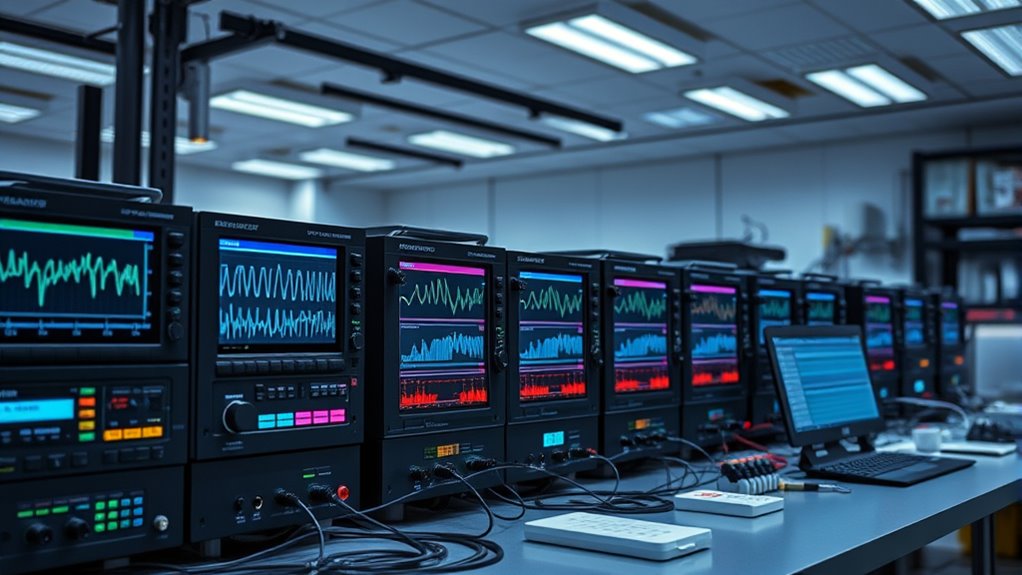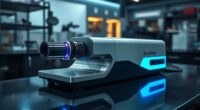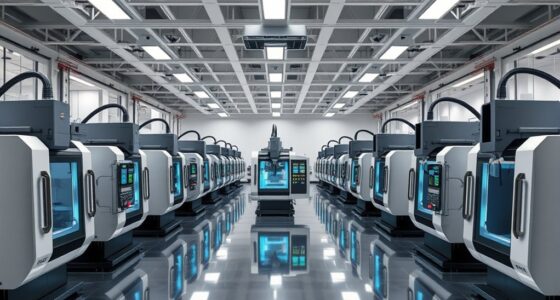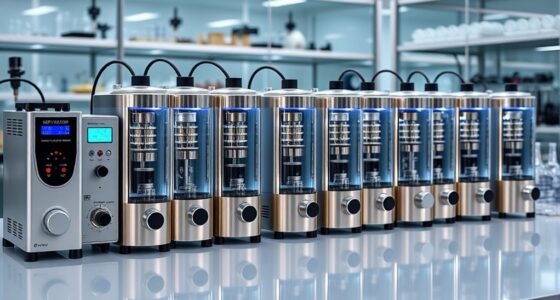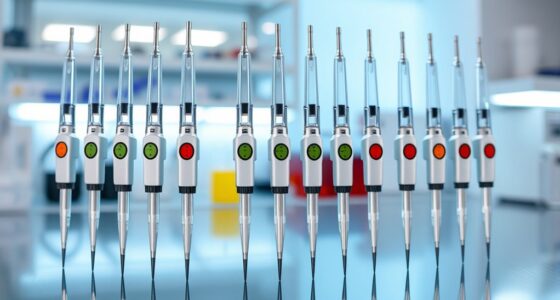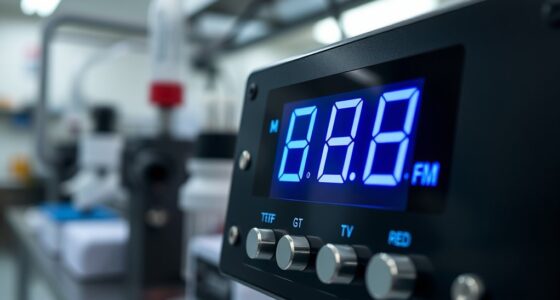If you’re looking for the best spectrum analyzers for lab use in 2025, I recommend considering models like the RIGOL RSA5032N, which offers high accuracy up to 6.5 GHz with ultra-real-time analysis. Portable options like RF Explorer SPA-7G provide versatile field measurement, while multi-function devices such as FNIRSI DPOS350P combine spectrum analysis with oscilloscopes and generators. For top performance, consider analyzers with wide frequency coverage, low noise floors, and intuitive interfaces. Keep reading to find the perfect fit for your lab needs.
Key Takeaways
- High-precision analyzers like RIGOL RSA5032N offer ultra-wide frequency ranges and fine spectral resolution for professional lab use.
- Portable and all-in-one devices such as FNIRSI DPOS350P and RF Explorer SPA-7G provide versatile RF testing in compact, field-ready formats.
- Advanced models feature real-time analysis, low noise levels, and integrated tracking generators, ensuring accurate measurements for complex environments.
- User-friendly interfaces with large touchscreens and data storage options facilitate efficient operation in lab and field settings.
- Upgrading spectrum analyzers extends measurement capabilities up to 12 GHz, future-proofing labs for evolving wireless standards.
RIGOL RSA5032N Spectrum Analyzer
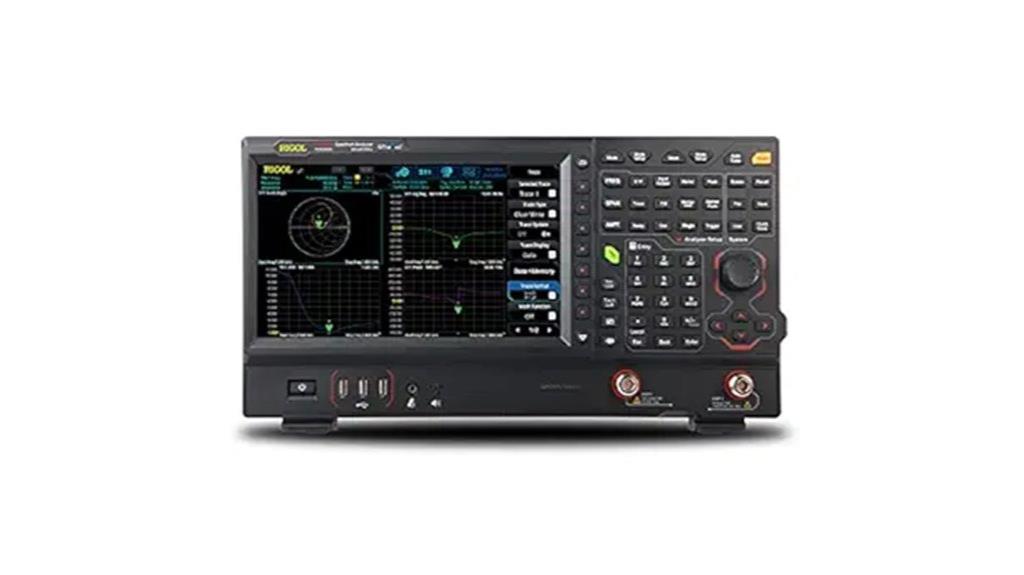
The RIGOL RSA5032N Spectrum Analyzer is an excellent choice for lab professionals who need precise, real-time measurements up to 6.5 GHz. Its Ultra-Real technology delivers highly accurate results, making it ideal for demanding testing environments. With a frequency range extending to 6.5 GHz and a built-in 6.5 GHz tracking generator, I can easily analyze signals and verify device performance. The analyzer offers a minimum RBW of 1 Hz, ensuring detailed resolution. Its ability to perform up to 40 MHz of real-time analysis, combined with advanced modes like vector signal analysis and EMI testing, makes it versatile and reliable for complex measurements.
Best For: lab professionals and engineers requiring precise, real-time spectrum analysis up to 6.5 GHz for complex testing and verification tasks.
Pros:
- Highly accurate measurements with less than 0.8 dB level uncertainty
- Up to 40 MHz of real-time analysis bandwidth for detailed signal monitoring
- Versatile with optional vector signal analysis, EMI testing, and advanced measurement modes
Cons:
- May be more expensive compared to basic spectrum analyzers
- Complex features could require additional training for optimal use
- Larger footprint might be less suitable for portable or space-constrained environments
RF Explorer Spectrum Analyzer SPA-7G (15MHz to 6.1GHz, Up to 7.5GHz)
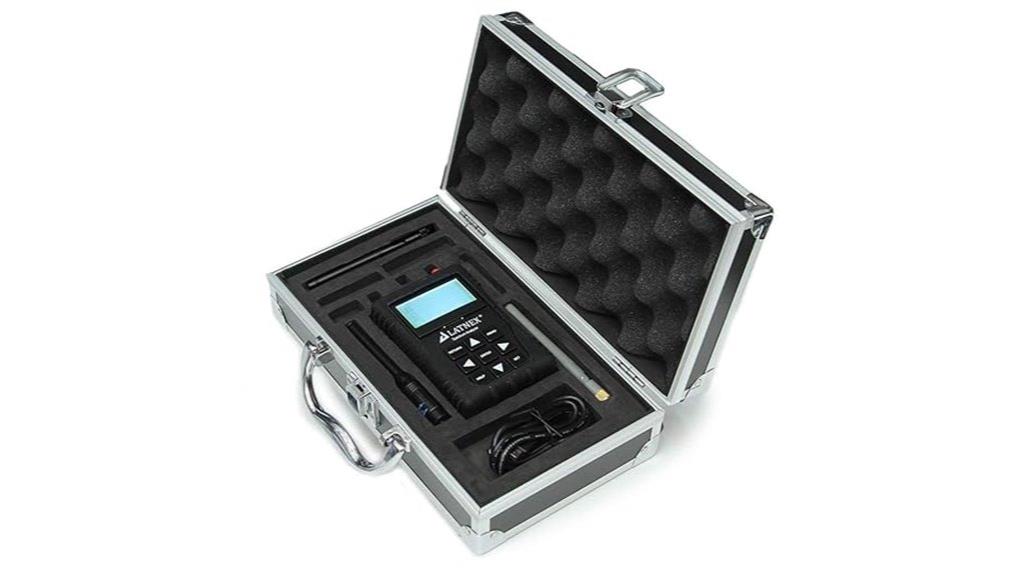
Looking for a versatile spectrum analyzer that covers a broad frequency range without gaps? The RF Explorer SPA-7G fits the bill perfectly. It spans from 15MHz up to 6.1GHz, with an optional upgrade to 7.5GHz, making it ideal for ham radio, WiFi, wireless devices, and audio engineering. Its wide frequency band allows extensive analysis, and the WiFi Analyzer Mode helps optimize channels and placement. Plus, it connects easily to Windows or Mac PCs with free professional software featuring advanced visualization. With a sturdy carry case, lifetime firmware updates, and excellent support, it’s a portable, reliable choice for both professionals and hobbyists.
Best For: hobbyists, ham radio operators, and professionals seeking a comprehensive, portable spectrum analyzer for wireless, WiFi, and audio applications across a broad frequency range.
Pros:
- Wide frequency coverage from 15MHz to 6.1GHz, upgradeable to 7.5GHz, with no gaps in spectrum analysis.
- User-friendly with free professional software featuring Waterfall 3D and 2D visualization for detailed analysis.
- Durable carry case and lifetime firmware updates ensure long-term reliability and ongoing improvements.
Cons:
- May be less suitable for extremely high-frequency measurements beyond 7.5GHz.
- Requires a Windows or Mac PC for full functionality, limiting use as a standalone device.
- Some users might find the initial setup and software configuration slightly complex for beginners.
FNIRSI DPOS350P 4-in-1 Tablet Oscilloscope
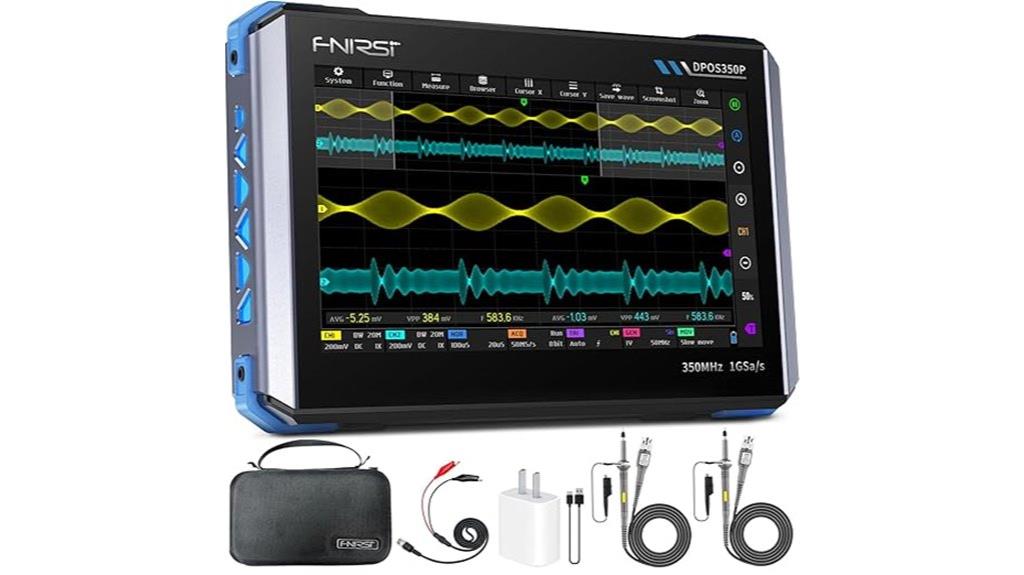
For students, hobbyists, and field technicians seeking a versatile and portable testing tool, the FNIRSI DPOS350P 4-in-1 Tablet Oscilloscope delivers impressive functionality in a compact form. It combines an oscilloscope, spectrum analyzer, frequency response analyzer, and DDS signal generator, all with a 350 MHz bandwidth and 1 GSa/s sampling rate. The 7-inch touchscreen, dual channels, and various measurement features make it highly capable. Its rechargeable 8000 mAh battery ensures portability, while USB-C charging adds convenience. Although it has some connectivity quirks and build limitations, overall, it’s an affordable, all-in-one device that’s perfect for educational, hobbyist, and fieldwork use.
Best For: students, hobbyists, and field technicians needing a versatile, portable, and affordable testing instrument for RF and analog signals.
Pros:
- Combines four essential testing functions in a compact, handheld device for convenience.
- Features a large 7-inch touchscreen with a clear digital phosphor display for precise measurements.
- Long-lasting 8000 mAh battery suitable for extended fieldwork and lab use.
Cons:
- Connectivity quirks, such as USB charging limitations and software recognition issues with waveform files.
- Build quality concerns, particularly with BNC connectors and overall durability.
- Limited spectrum analyzer range adjustment options and lack of external trigger port for advanced triggering.
FNRSI DPOS350P 4-in-1 Oscilloscope with Signal Generator and Spectrum Analyzer

If you’re seeking an all-in-one tool that combines high-performance measurement capabilities, the FNRSI DPOS350P 4-in-1 Oscilloscope stands out. It integrates a 350MHz digital phosphor oscilloscope, 50MHz signal generator, spectrum analyzer, and frequency response analyzer in one device. With dual channels, 1GSa/s sampling, and a 50,000 waveform/sec refresh rate, it captures signals with precision. The 50MHz waveform generator offers versatile waveforms and extensive storage, while the spectrum analyzer covers 200kHz to 350MHz with detailed FFT analysis. Its intuitive touchscreen interface, high resolution, and portable design make it ideal for comprehensive lab diagnostics and RF troubleshooting.
Best For: Electronics engineers, RF technicians, and lab professionals seeking an all-in-one measurement solution for diagnostics, testing, and troubleshooting.
Pros:
- Combines multiple advanced measurement tools (oscilloscope, signal generator, spectrum analyzer, frequency response analyzer) in one device for versatile testing.
- High sampling rate (1GSa/s) and fast refresh rate (50,000 waveforms/sec) enable precise signal capture and analysis.
- User-friendly high-resolution touchscreen interface with extensive storage for waveforms and screenshots enhances usability.
Cons:
- The device may be relatively expensive compared to standalone instruments.
- Limited frequency coverage of the signal generator (50MHz) may not suit ultra-high frequency applications.
- Portability might be constrained by size and power requirements for field use in some environments.
SeeSii TinySA Ultra+ Spectrum Analyzer (2025 Upgraded 4 Inch)
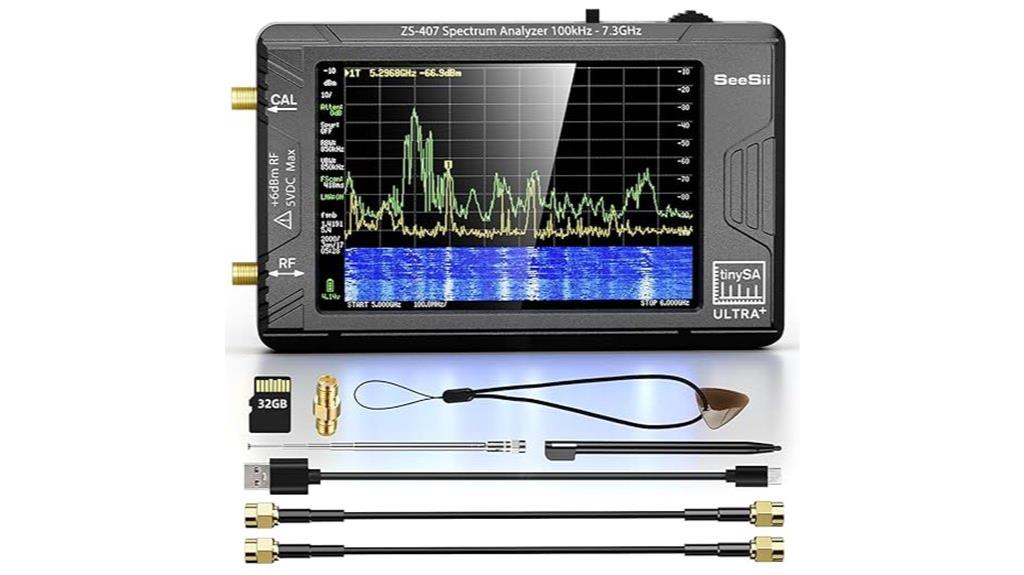
The SeeSii TinySA Ultra+ Spectrum Analyzer (2025 Upgraded 4 Inch) stands out as an ideal tool for professionals who need precise, portable spectrum analysis in the field. Its 4-inch HD touchscreen and user-friendly interface make navigation effortless, while ESD protection guarantees durability. Supporting a frequency range from 100kHz to 7.3GHz and calibration up to 8GHz, it’s perfect for 5G, Wi-Fi 6E, and satellite signals. The device doubles as a signal generator, producing various RF waves across multiple bands. With real-time data transfer, a 32GB MicroSD, and up to 10 hours of battery life, it’s a versatile, field-ready solution for RF troubleshooting and development.
Best For: RF engineers, satellite technicians, and wireless professionals seeking a portable, high-precision spectrum analyzer for field measurements and signal troubleshooting.
Pros:
- Supports broad frequency range from 100kHz to 7.3GHz, calibrated up to 8GHz for versatile applications
- Features a 4-inch HD touchscreen with an intuitive interface for easy operation in the field
- Combines spectrum analysis with signal generation, offering a comprehensive RF testing solution
Cons:
- Limited RBW range (200Hz–850kHz) may not suit ultra-high resolution needs for some specialized tests
- Battery life, while up to 10 hours, may still require recharge during extended field operations
- The device’s complexity may require some training for optimal utilization of its advanced features
AURSINC TinySA Ultra+ Spectrum Analyzer with 50W Attenuator and Signal Generator

The AURSINC TinySA Ultra+ Spectrum Analyzer stands out as an ideal choice for professionals and serious hobbyists who need portable, high-performance RF testing. It covers frequencies from 100kHz to 5.4GHz, with Ultra mode extending measurements up to 12GHz. The device features a bright 4-inch touchscreen, built-in 32GB SD card, and dual functions as a spectrum analyzer and signal generator. Its included 50W, 50dB attenuator guarantees safe testing of high-power signals. With high sensitivity, adjustable RBW, and reliable accuracy, it’s perfect for RF troubleshooting, noise monitoring, and transmitter verification both in the lab and field, delivering professional-grade results in a compact form.
Best For: RF professionals, hobbyists, and technicians seeking a portable, high-performance spectrum analyzer with versatile signal generation capabilities.
Pros:
- Combines spectrum analysis and signal generation in a compact, portable device.
- Wide frequency coverage from 100kHz to 12GHz with high sensitivity and accuracy.
- User-friendly touchscreen interface and built-in data storage for easy operation and data management.
Cons:
- May require some initial familiarization for beginners unfamiliar with RF testing.
- The included attenuator and accessories, while robust, may need careful handling to maintain calibration.
- Limited resolution bandwidth range (200Hz to 850kHz) might not suit extremely narrowband testing needs.
AURSINC TinySA Ultra+ Spectrum Analyzer with Signal Generator and 32GB Card

Looking for a portable yet powerful spectrum analyzer that combines measurement versatility with ease of use? The AURSINC TinySA Ultra+ fits the bill perfectly. It features a hardware upgrade, a bright 4-inch touchscreen, and a measurement range from 100kHz to 5.4GHz, extending to 6GHz in Ultra mode. With a built-in 32GB SD card, data sharing is straightforward, and the device’s battery lasts over three hours. It functions as both a spectrum analyzer and signal generator, supporting PC control via USB and offering intuitive operation. Ideal for RF troubleshooting, amateur radio, and wireless testing, it delivers reliable, professional-grade results in a compact form.
Best For: RF hobbyists, amateur radio operators, and professionals seeking a portable, versatile spectrum analyzer with professional-grade features.
Pros:
- Combines spectrum analysis and signal generation in one compact device for versatile testing.
- Bright, easy-to-read touchscreen with intuitive controls simplifies operation for beginners and experts alike.
- Built-in 32GB SD card allows for quick data sharing and storage during on-site measurements.
Cons:
- Limited to a maximum frequency of 6GHz in Ultra mode, which may not cover all high-frequency applications.
- The device’s advanced features require some learning, and extensive manual or tutorials are recommended.
- Software updates and hardware calibration are necessary for optimal performance over time.
SeeSii TinySA Spectrum Analyzer (V0.4.6.1, 2025 Upgraded)

For lab professionals seeking a versatile and portable spectrum analyzer, the SeeSii TinySA Ultra+ V0.4.6.1 stands out with its broad measurement range up to 5.3GHz and dual functionality as both an analyzer and signal generator. Its 4-inch touchscreen simplifies operation, while enhanced ESD protection ensures durability in rugged environments. The built-in 32GB micro SD card makes data recording, sharing, and storage effortless. It covers frequencies from 100kHz to 5.3GHz, with ultra mode extending up to 6GHz. Its ability to function as a signal generator, combined with PC connectivity and long battery life, makes it a top choice for versatile field testing.
Best For: lab professionals and field technicians seeking a versatile, portable spectrum analyzer with broad frequency coverage and dual signal analysis and generation capabilities.
Pros:
- Wide measurement range up to 5.3GHz and ultra mode extending to 6GHz for comprehensive testing.
- Dual functionality as both a spectrum analyzer and a signal generator, enhancing testing versatility.
- Built-in 32GB micro SD card and 4-inch touchscreen for easy data management and user-friendly operation.
Cons:
- May be more expensive than basic spectrum analyzers due to advanced features.
- Requires familiarity with spectrum analysis and signal generation for optimal use.
- Limited to USB connectivity, which may require additional adapters or software for certain PC configurations.
Siglent Spectrum Analyzer SSA3021X (9 kHz to 2.1 GHz)
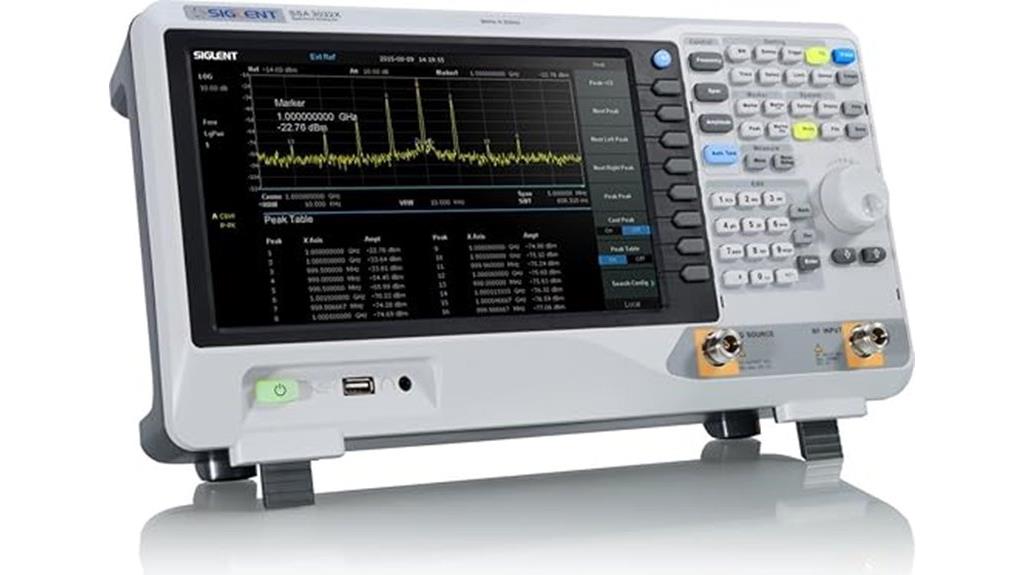
If you’re seeking a high-performance spectrum analyzer suitable for detailed RF testing, the Siglent SSA3021X stands out with its all-digital IF technology, which guarantees precise measurements and enhanced accuracy. Covering frequencies from 9 kHz to 2.1 GHz, it includes a free tracking generator, making it versatile for various applications. Its noise floor of -161 dBm/Hz and phase noise at -98 dBc/Hz at 1 GHz ensure clean signal analysis. The minimum RBW of 1 Hz allows for highly detailed spectral measurements. Overall, the SSA3021X offers extensive measurement capabilities in a compact, reliable package ideal for demanding RF labs.
Best For: RF engineers and technicians requiring precise, detailed spectral analysis across a wide frequency range from 9 kHz to 2.1 GHz in professional testing environments.
Pros:
- Utilizes all-digital IF technology for high accuracy and reliable measurements
- Extremely low noise floor of -161 dBm/Hz and excellent phase noise performance at -98 dBc/Hz at 1 GHz
- Minimum RBW of 1 Hz allows for highly detailed spectral resolution
Cons:
- Limited to a maximum frequency of 2.1 GHz, not suitable for ultra-high frequency applications
- May be more expensive than basic spectrum analyzers with fewer features
- Compact design might lack some advanced features found in larger, more expensive models
AURSINC Portable Spectrum Analyzer with Touchscreen
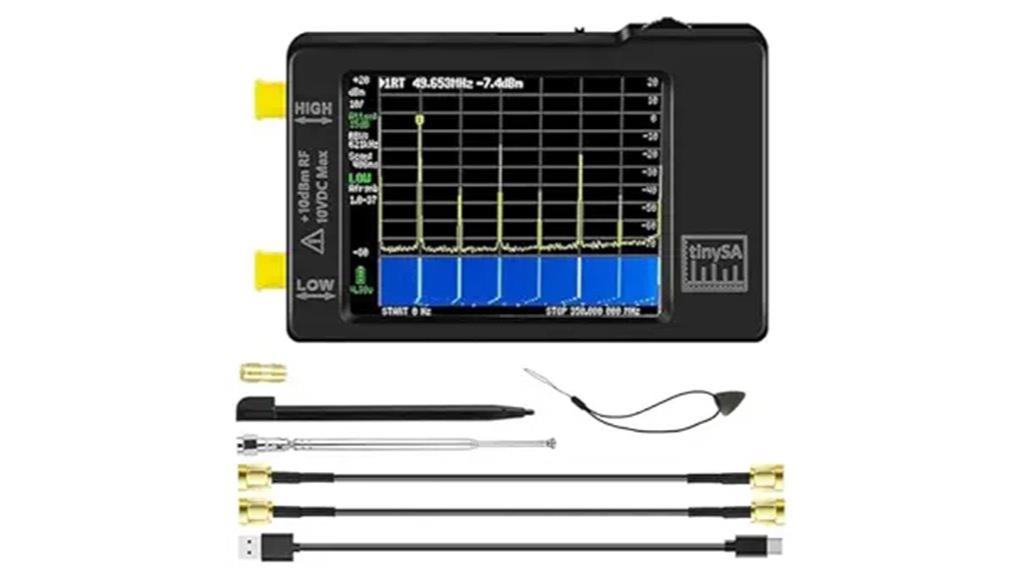
The AURSINC Portable Spectrum Analyzer with Touchscreen stands out as an ideal choice for both hobbyists and professionals who need a compact yet powerful tool for accurate RF analysis. Its 2.8-inch touchscreen offers intuitive control, while the device’s broad frequency range from 100 kHz to 960 MHz covers most applications. With built-in calibration signals, it doubles as a signal generator, perfect for testing and troubleshooting. The device’s portability, rechargeable battery, and PC connectivity via USB make it versatile for fieldwork. Its durable design, combined with detailed spectrum analysis capabilities, makes it a reliable and cost-effective solution for RF environment assessment and radio calibration.
Best For: hobbyists, ham radio operators, and RF professionals seeking a portable, versatile spectrum analyzer with built-in signal generation and easy PC connectivity.
Pros:
- Compact, lightweight design with a user-friendly 2.8-inch touchscreen interface.
- Wide frequency coverage from 100 kHz to 960 MHz, suitable for various RF applications.
- Built-in calibration signal generator and PC control capabilities enhance functionality and testing accuracy.
Cons:
- Some accessories may arrive damaged or require replacement.
- Limited support from suppliers can pose challenges for troubleshooting.
- Slightly lower sensitivity compared to high-end professional spectrum analyzers.
Upgraded TinySA Ultra Spectrum Analyzer
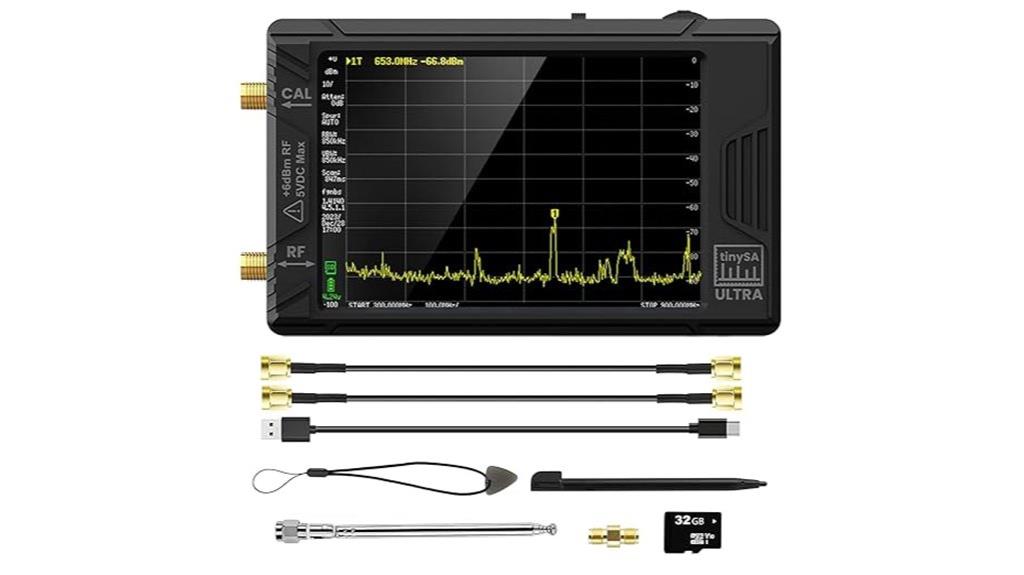
The Upgraded TinySA Ultra Spectrum Analyzer excels for professionals and advanced hobbyists who need high-precision measurements in a portable package. Its 4-inch touchscreen display and broad frequency range of 100kHz to 5.3GHz make it versatile for various RF tasks. With a built-in 32GB micro SD card, data recording is straightforward, and adjustable RBW filters from 200Hz to 850kHz allow for detailed signal analysis. The device functions as both a spectrum analyzer and a signal generator, offering sine, square, or tone outputs. USB connectivity via Tinysa-APP enables seamless data transfer and device control, making it a compact yet powerful measurement tool.
Best For: professional RF engineers and advanced hobbyists seeking high-precision, portable spectrum analysis and signal generation capabilities across a broad frequency range.
Pros:
- Wide frequency coverage from 100kHz to 5.3GHz with ultra-wide spectrum mode up to 6GHz in Ultra mode
- High-precision measurements with adjustable RBW filters from 200Hz to 850kHz
- Dual functionality as both a spectrum analyzer and a signal generator with built-in calibration
Cons:
- Firmware update process can be challenging and may require technical patience
- Hardware issues such as crooked screens have been reported by some users
- Limited compatibility with LNA due to input step attenuator specifications
Handheld Spectrometer Spectrum Analyzer Bundle Kit for LED Light Testing
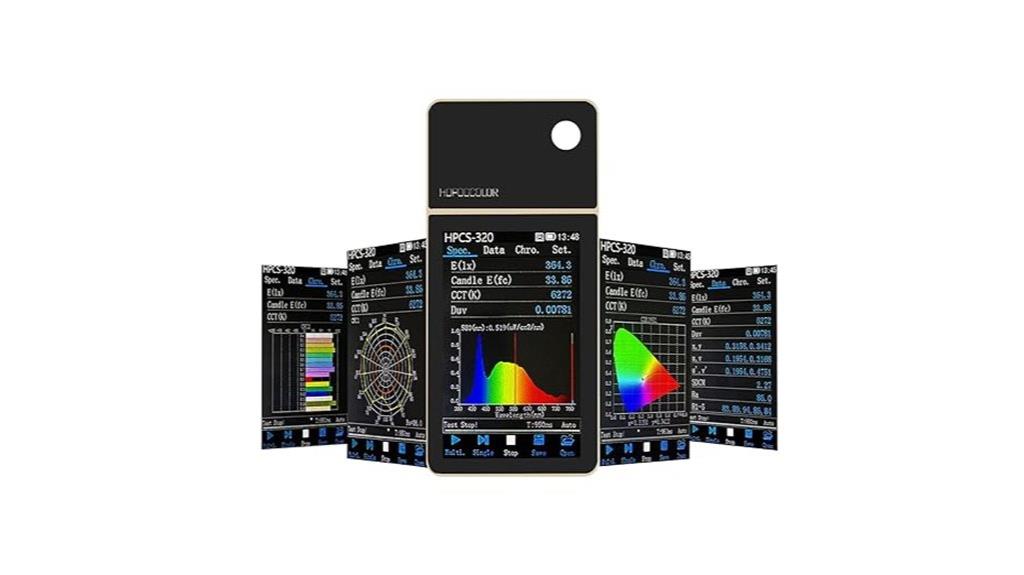
Looking for a reliable handheld spectrum analyzer that offers precise LED light testing? The Spectrometer HPSC-320 is perfect for this. It’s a portable device that captures spectral data from 370-780 nm, suitable for various applications like plant growth labs, engineering projects, and on-site lighting assessments. Its durable aluminum body and 3.5-inch touch screen make it easy to operate in different environments. Plus, the included PC software allows for detailed analysis and data export, streamlining research and quality control. Whether you’re testing LED sources or natural sunlight, this kit provides accurate, extensive light measurement in a compact, user-friendly package.
Best For: professionals and hobbyists seeking precise LED light testing and spectral analysis in various environments including labs, industrial sites, and homes.
Pros:
- Accurate spectral measurement across 370-780 nm wavelength range
- Durable aluminum alloy body for long-lasting use in diverse settings
- Intuitive 3.5-inch touch LCD and comprehensive PC software for easy operation and detailed analysis
Cons:
- May require familiarity with spectral data interpretation for optimal use
- Limited to measurement of light sources within the 370-780 nm range, not suitable for other spectra
- The device and software might have a learning curve for new users
Rigol DSA815-TG Spectrum Analyzer with Pre-Amplifier and Tracking Generator

If you’re seeking a reliable and versatile spectrum analyzer for lab use, the Rigol DSA815-TG stands out thanks to its built-in tracking generator and RF preamplifier. It covers 9 kHz to 1.5 GHz, ideal for RF filtering, interference analysis, and radio tuning. Its large 8-inch display offers clear visuals, while auto functions simplify operation. Digital IF technology guarantees accurate, stable measurements, even for weak signals. Although some features require extra modules, the DSA815-TG provides excellent performance at a competitive price point. Its portability and ease of use make it suitable for both lab environments and field testing.
Best For: RF engineers, technicians, and hobbyists seeking a reliable, portable spectrum analyzer with built-in tracking generator for lab and field RF testing up to 1.5 GHz.
Pros:
- Large 8-inch high-resolution display for easy signal analysis and navigation
- Built-in tracking generator and RF preamplifier enhance measurement capabilities
- Digital IF technology ensures stable, accurate detection of weak and closely spaced signals
Cons:
- Additional modules for extended bandwidth and advanced features require extra purchase
- Limited remote control options, such as lack of LAN connectivity and split-screen trace display
- Some units may arrive used or damaged, and customer support experiences vary
SIGLENT SVA1015X Spectrum Analyzer with Tracking Generator

For professionals seeking a versatile and reliable spectrum analyzer, the SIGLENT SVA1015X stands out thanks to its integrated tracking generator, allowing thorough signal testing without extra gear. Covering frequencies from 9 kHz to 1.5 GHz, it offers detailed spectrum analysis across a broad range. Its vector network analysis from 100 kHz to 1.5 GHz enables precise measurement of S-parameters and impedance. With a noise level of -156 dBm/Hz and 1.2 dB amplitude accuracy, it ensures accurate results. Additionally, adjustable phase noise measurement and flexible RBW settings make it suitable for detailed phase stability analysis, all in a compact, user-friendly package.
Best For: professionals and engineers needing a versatile, high-precision spectrum and vector network analyzer with integrated tracking generator for comprehensive RF testing across a wide frequency range.
Pros:
- Integrated tracking generator simplifies testing setup and measurement procedures
- Wide frequency coverage from 9 kHz to 1.5 GHz supports diverse applications
- High sensitivity with -156 dBm/Hz noise floor and 1.2 dB amplitude accuracy ensures precise results
Cons:
- Limited to a maximum frequency of 1.5 GHz, not suitable for higher-band applications
- The device’s advanced features may require a learning curve for new users
- Compact design might limit some advanced measurement capabilities compared to larger, more specialized equipment
Spectrum Analyzer Ultra+ 7.3GHz with Signal Generator
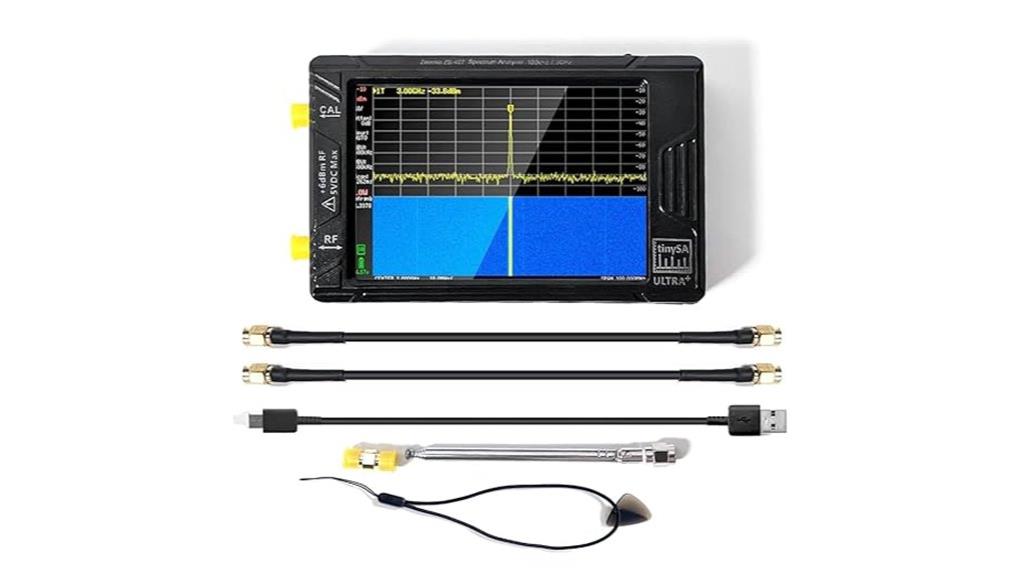
The Spectrum Analyzer Ultra+ 7.3GHz with Signal Generator stands out as an ideal choice for professionals who need extensive RF analysis combined with versatile signal generation capabilities. Its wide frequency coverage from 100kHz to 7.3GHz includes HF, VHF, UHF, and beyond 6GHz bands like 5G NR, WiFi 6E, and IoT signals. The device’s real-time spectrum analysis captures transient signals with 97ns POI detection, making interference debugging efficient. Weighing only 850g with a 6-hour battery, it’s portable and perfect for fieldwork. Its high-visibility touchscreen and drag-to-measure spectrogram streamline complex RF tasks across various applications.
Best For: RF engineers, field technicians, and researchers requiring comprehensive RF analysis and versatile signal generation in a portable, easy-to-use device.
Pros:
- Wide frequency coverage from 100kHz to 7.3GHz, including advanced bands like 5G NR and WiFi 6E.
- Real-time spectrum analysis with 97ns POI detection, ideal for quick interference debugging.
- Lightweight (850g) with a 6-hour battery, suitable for portable fieldwork.
Cons:
- Limited signal generator output range (100kHz-900MHz), which may not cover all testing needs.
- The device’s advanced features may require a learning curve for new users.
- Higher cost compared to simpler spectrum analyzers without integrated signal generators.
Factors to Consider When Choosing Spectrum Analyzers for Labs

When selecting a spectrum analyzer for the lab, I focus on key factors that impact performance and usability. These include the frequency range coverage, resolution bandwidth options, and measurement accuracy, which guarantee precise results. Additionally, I consider portability, connectivity, and software features to match the specific needs of my testing environment.
Frequency Range Coverage
Have you ever wondered how to choose a spectrum analyzer that can handle all your testing needs? The key is evaluating the frequency range coverage. A broad range, from a few kilohertz to several gigahertz, allows you to detect and analyze signals across multiple bands. For modern applications like 5G, WiFi 6E, or satellite communications, coverage up to 6 GHz or higher is essential. Extended frequency ranges enable exhaustive RF environment analysis, capturing both low- and high-frequency signals. Your choice should match your specific use case, whether it’s amateur radio, RF design, or industrial testing. Upgrading to models with ultra-wide or multi-range capabilities offers flexibility and future-proofing, ensuring you’re prepared for evolving wireless standards and diverse testing scenarios.
Resolution Bandwidth Options
Choosing the right spectrum analyzer involves more than just selecting the broadest frequency range; it also requires attention to resolution bandwidth (RBW) options. RBW determines the smallest frequency difference the analyzer can distinguish, directly impacting how well it can resolve closely spaced signals. Some analyzers offer RBW settings as narrow as 1 Hz, ideal for detailed spectral analysis and precise measurements. Conversely, wider RBW settings allow faster sweep times but can compromise resolution, making it harder to separate adjacent signals. Many analyzers feature adjustable RBW filters, typically from a few Hz up to several hundred kHz, giving users flexibility to balance resolution against measurement speed. Picking the right RBW depends on your specific measurement needs, whether it’s noise analysis, intermodulation testing, or signal separation.
Measurement Accuracy & Noise
How do you guarantee your spectrum analyzer provides accurate measurements in a noisy environment? It starts with low measurement uncertainty, ideally below 0.8 dB, to confirm precise quantification. A low displayed average noise level (DANL), like -161 dBm/Hz, allows you to detect weaker signals despite background noise. Phase noise performance, such as -98 dBc/Hz at 1 GHz offset, is critical for evaluating signal stability and spectral purity. Adjusting the Resolution Bandwidth (RBW) impacts the noise floor and signal distinction, so selecting the right setting is key. Additionally, effective noise suppression techniques—like digital IF filtering and preamplifiers—help maintain measurement integrity. These features collectively guarantee your analyzer delivers reliable, accurate results even in challenging, noisy lab environments.
Portability & Size
When selecting a spectrum analyzer for lab use, its size and portability can substantially impact your workflow. Portable analyzers are typically compact, about the size of a tablet or handheld device, making them easy to transport for fieldwork or on-site testing. They often come with integrated batteries, enabling cordless operation and enhancing mobility in diverse environments. Weighing between under 1 kg and around 3 kg, these devices strike a balance between portability and measurement capability. However, their reduced size can limit physical controls and display size, requiring a compromise between ease of use and portability. Many portable models also feature foldable or detachable antennas, maximizing space efficiency and simplifying transportation. Overall, size and portability are key factors to consider based on your specific lab needs.
Connectivity & Software
Connectivity and software features are indispensable considerations because they directly impact how easily you can control, automate, and analyze measurements with your spectrum analyzer. Compatibility with PC control software and remote interfaces simplifies data management and measurement processes. Supporting standard communication protocols like USB, LAN, or serial ports allows seamless integration into existing lab systems. Dedicated software applications for spectrum analysis, data visualization, and firmware updates streamline operations and improve accuracy. The ability to export data in common formats such as CSV or TXT makes further processing and reporting straightforward. Additionally, firmware update capabilities and software stability are crucial for maintaining measurement precision and device reliability over time. Well-designed connectivity and software features ensure your spectrum analyzer fits smoothly into your workflow and long-term lab setup.
Measurement Speed & Range
Measurement speed and range are key factors that directly influence the efficiency and effectiveness of a spectrum analyzer in a laboratory setting. Faster measurement speeds allow me to scan and analyze signals quickly, which is vital when testing dynamic environments or identifying transient events. A wider frequency range means I can cover multiple bands without switching devices, saving time and reducing complexity. A high real-time analysis bandwidth, such as 40 MHz or more, enables me to capture rapidly changing signals accurately. Additionally, a low minimum resolution bandwidth, like 1 Hz, helps resolve closely spaced signals and measure fine spectral details. Altogether, these features guarantee I can perform thorough, precise measurements swiftly, making them essential considerations when choosing a spectrum analyzer for lab work.
Additional Measurement Features
Additional measurement features substantially enhance the versatility of spectrum analyzers, allowing me to perform more detailed and thorough analyses. Features like vector network analysis, EMI testing, and phase noise measurement expand capabilities beyond basic frequency and amplitude detection. Precise control over resolution bandwidth (RBW) and video bandwidth (VBW) improves signal resolution and noise floor management, especially during complex measurements. Trigger masks, advanced marker functions, and transient capture enable detailed analysis of signal behavior and interference phenomena. Some analyzers include automatic calibration, harmonic analysis, and swept tuning, ensuring accurate, repeatable results. Optional modules or software upgrades can further extend measurement options, including S-parameters, modulation analysis, and time-domain studies. These features markedly enhance measurement accuracy and adaptability in professional lab environments.
Cost & Licensing Fees
Choosing the right spectrum analyzer involves more than just matching features to your technical needs; cost and licensing fees play a significant role in the decision-making process. Spectrum analyzers vary widely in price, from a few hundred dollars for basic models to tens of thousands for professional-grade units. Many high-end devices require additional licensing fees to release advanced features like extended bandwidth, VNA capabilities, or specific measurement modules. Some models include core functionalities in the base price, while others secure essential features behind optional upgrades or subscriptions. Licensing fees can also apply for software control, remote operation, or calibration services, adding to the overall ownership costs. Considering these factors helps guarantee you select a device that meets your needs without unexpected expenses down the line.
Frequently Asked Questions
What Are the Main Differences Between Handheld and Benchtop Spectrum Analyzers?
Handheld spectrum analyzers are portable, lightweight, and perfect for fieldwork or quick inspections. They’re easy to carry and operate on the go, but typically have lower resolution and fewer advanced features. Benchtop analyzers, on the other hand, are larger, more powerful, and designed for detailed lab analysis. They offer higher accuracy, better sensitivity, and a wide range of functions, making them ideal for in-depth testing and research.
How Does Frequency Range Impact Spectrum Analyzer Performance?
Back in my heyday, I’d say frequency range is vital because it determines what signals I can analyze. A broader range means I can detect higher and lower frequencies, making my measurements more versatile and accurate. If you’re working with a wide variety of signals, a spectrum analyzer with an extensive frequency range will give you better insights and more precise data. It’s like having a wider lens for your measurements.
What Features Are Essential for Lab-Grade Spectrum Analyzers?
When choosing a lab-grade spectrum analyzer, I look for high sensitivity, wide frequency range, and excellent dynamic range, which guarantee precise measurements across various signals. I also prioritize features like low phase noise, advanced filtering options, and user-friendly interfaces. These elements help me analyze complex signals accurately, troubleshoot issues efficiently, and ensure reliable results in demanding lab environments.
How Important Is Portability Versus Advanced Capabilities?
Portability is like a trusty compass guiding me through fieldwork, but advanced capabilities are the sturdy map that guarantees I don’t get lost in complex signals. I believe in a balance—sometimes I need to go mobile, yet other times, detailed analysis demands powerful features. Ultimately, it’s about matching the tool to the task, ensuring I have both mobility and depth when I need them most.
What Maintenance and Calibration Are Required for Long-Term Accuracy?
I make certain to regularly calibrate my spectrum analyzer using traceable calibration standards to maintain accuracy. I also keep the device clean and check connections often, as dust and loose cables can affect readings. Additionally, I follow the manufacturer’s recommended maintenance schedule, including software updates and internal inspections. This routine helps me ensure long-term precision and reliable performance in my lab work.
Conclusion
Choosing the right spectrum analyzer can substantially boost your lab’s testing accuracy. Did you know that over 60% of engineers report improved measurement efficiency after upgrading their equipment? Whether you need a compact model like the TinySA or a feature-rich analyzer like the Rigol RSA5032N, selecting the right tool makes all the difference. Invest wisely, and you’ll streamline your workflows and ensure precise results every time.
